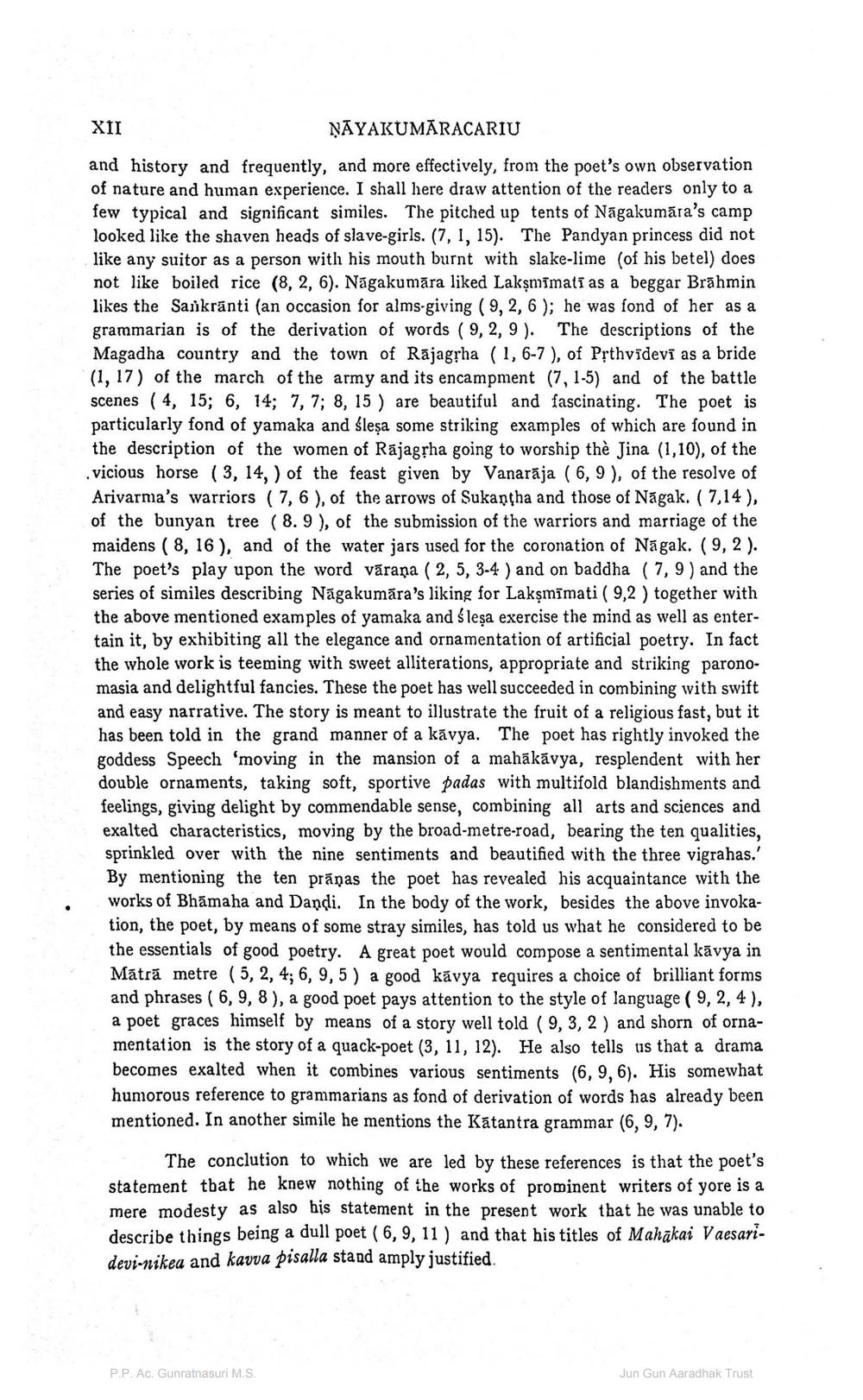________________ XII NAYAKUMARACARIU and history and frequently, and more effectively, from the poet's own observation of nature and human experience. I shall here draw attention of the readers only to a few typical and significant similes. The pitched up tents of Nagakumara's camp looked like the shaven heads of slave-girls. (7, 1, 15). The Pandyan princess did not like any suitor as a person with his mouth burnt with slake-lime (of his betel) does not like boiled rice (8, 2, 6). Nagakumara liked Laksmimati as a beggar Brahmin likes the Saukranti (an occasion for alms-giving (9,2, 6); he was fond of her as a grammarian is of the derivation of words (9, 2, 9). The descriptions of the Magadha country and the town of Rajagrha (1, 6-7), of Prthvidevi as a bride (1, 17) of the march of the army and its encampment (7, 1-5) and of the battle scenes ( 4, 15; 6, 14; 7, 7; 8, 15 ) are beautiful and fascinating. The poet is particularly fond of yamaka and slesa some striking examples of which are found in the description of the women of Rajaglha going to worship the Jina (1,10), of the .vicious horse (3, 14, ) of the feast given by Vanaraja (6,9 ), of the resolve of Arivarma's warriors ( 7, 6), of the arrows of Sukantha and those of Nagak. (7,14 ), of the bunyan tree (8.9), of the submission of the warriors and marriage of the maidens ( 8, 16), and of the water jars used for the coronation of Nagak. (9,2). The poet's play upon the word varana (2, 5, 3-4 ) and on baddha (7,9 ) and the series of similes describing Nagakumara's liking for Laksmimati ( 92 ) together with the above mentioned examples of yamaka and Slesa exercise the mind as well as entertain it, by exhibiting all the elegance and ornamentation of artificial poetry. In fact the whole work is teeming with sweet alliterations, appropriate and striking paronomasia and delightful fancies. These the poet has well succeeded in combining with swift and easy narrative. The story is meant to illustrate the fruit of a religious fast, but it has been told in the grand manner of a kavya. The poet has rightly invoked the goddess Speech moving in the mansion of a mahakavya, resplendent with her double ornaments, taking soft, sportive padas with multifold blandishments and feelings, giving delight by commendable sense, combining all arts and sciences and exalted characteristics, moving by the broad-metre-road, bearing the ten qualities, sprinkled over with the nine sentiments and beautified with the three vigrahas.' By mentioning the ten pranas the poet has revealed his acquaintance with the works of Bhamaha and Dandi. In the body of the work, besides the above invokation, the poet, by means of some stray similes, has told us what he considered to be the essentials of good poetry. A great poet would compose a sentimental kavya in Matra metre ( 5, 2, 4, 6, 9,5 ) a good kavya requires a choice of brilliant forms and phrases ( 6, 9,8), a good poet pays attention to the style of language ( 9, 2, 4 ), a poet graces himself by means of a story well told ( 9, 3, 2 ) and shorn of ornamentation is the story of a quack-poet (3, 11, 12). He also tells us that a drama becomes exalted when it combines various sentiments (6, 9,6). His somewhat humorous reference to grammarians as fond of derivation of words has already been mentioned. In another simile he mentions the Katantra grammar (6, 9, 7). The conclution to which we are led by these references is that the poet's statement that he knew nothing of the works of prominent writers of yore is a mere modesty as also his statement in the present work that he was unable to describe things being a dull poet (6, 9, 11 ) and that his titles of Mahakai Vaesaridevi-nikea and kavva pisalla stand amply justified. P.P.AC. Gunratnasuri M.S Jun Gun Aaradhak Trust




